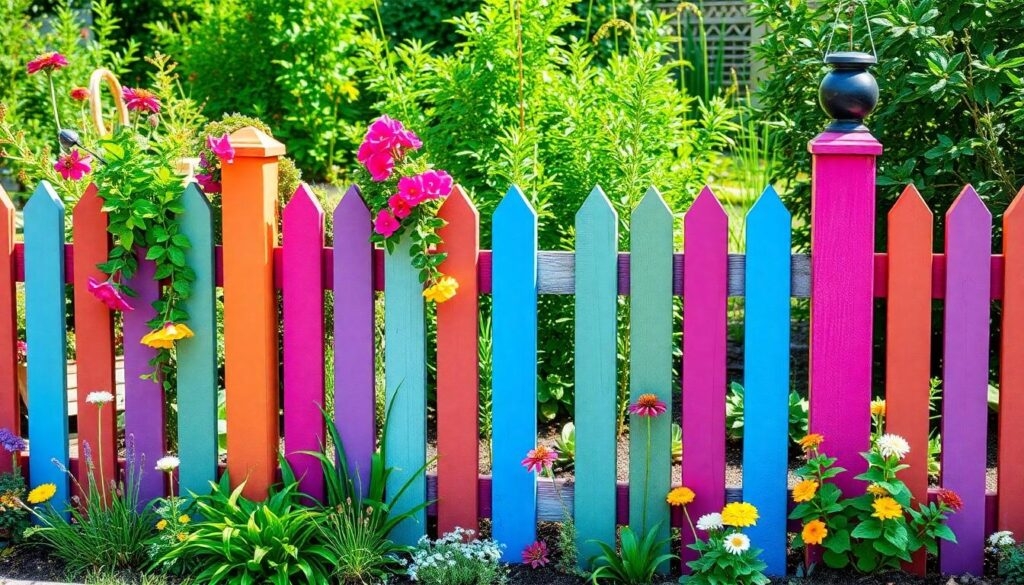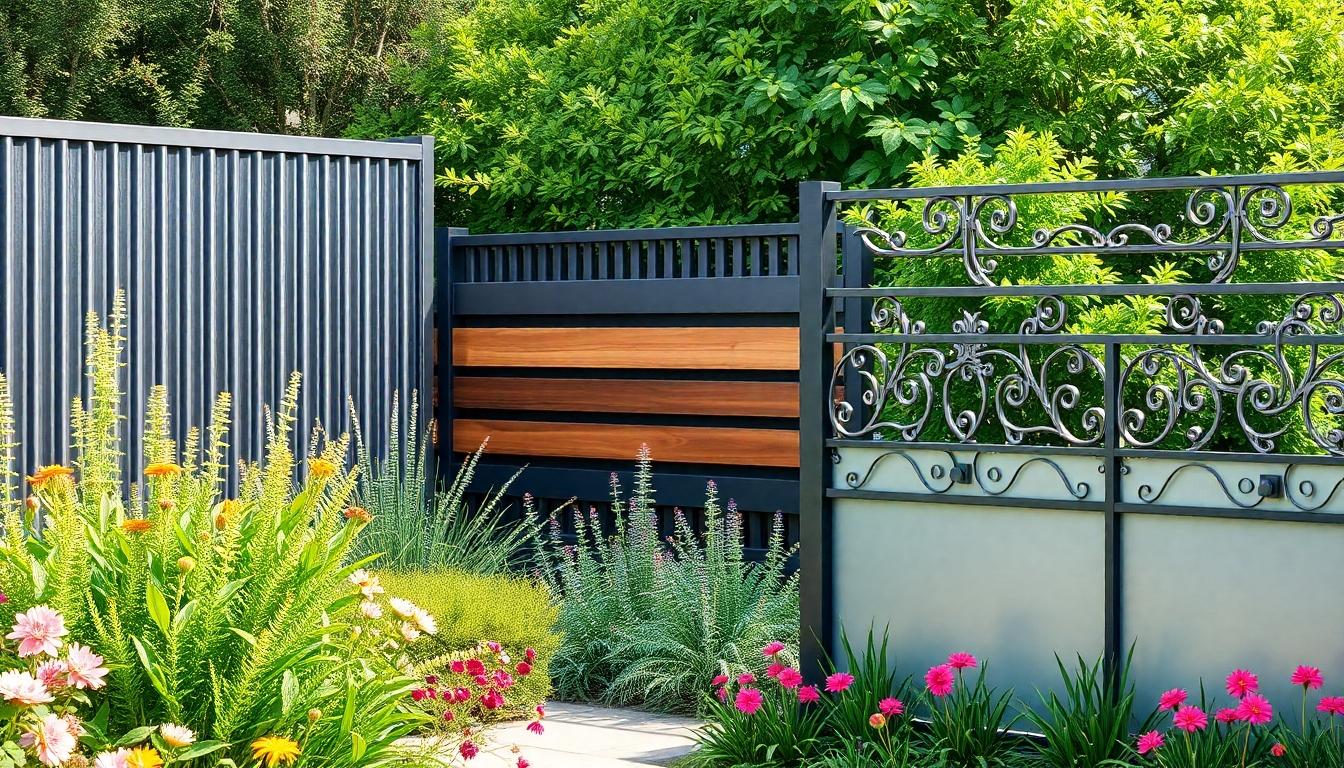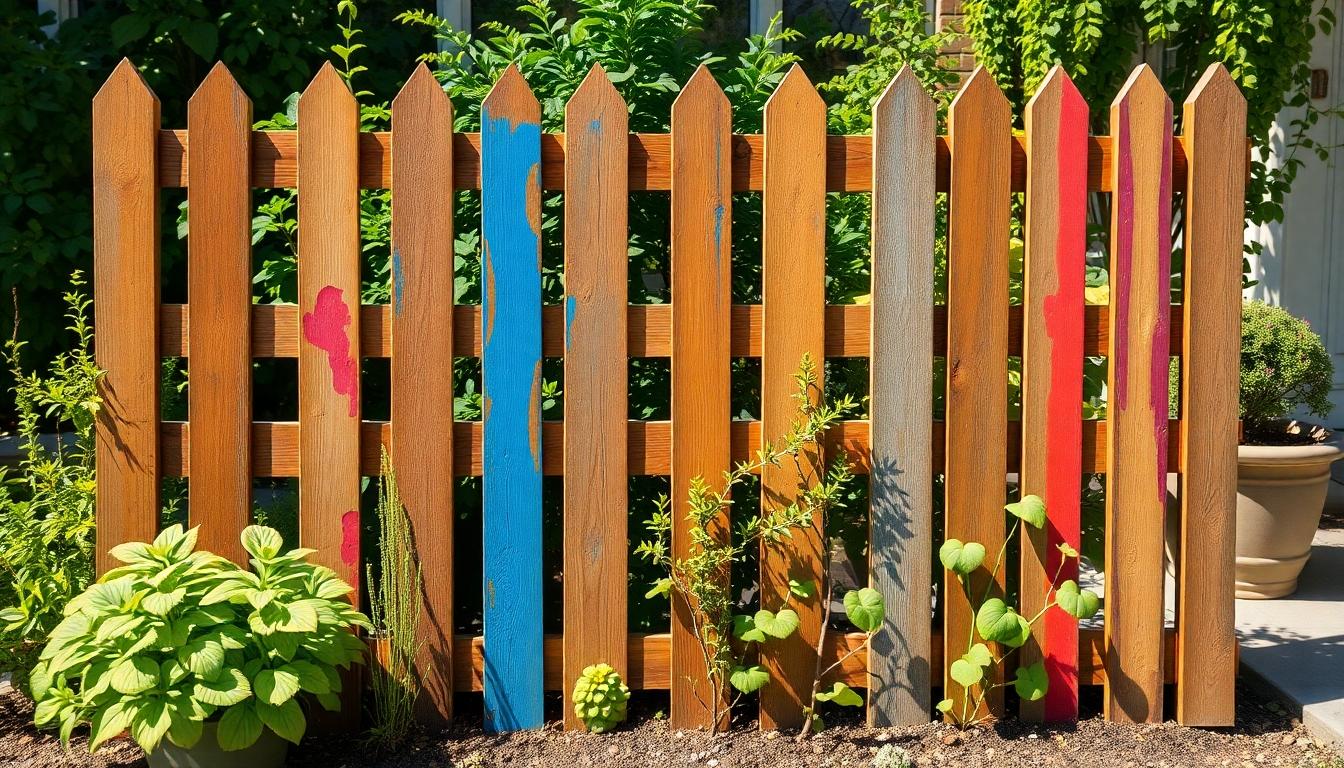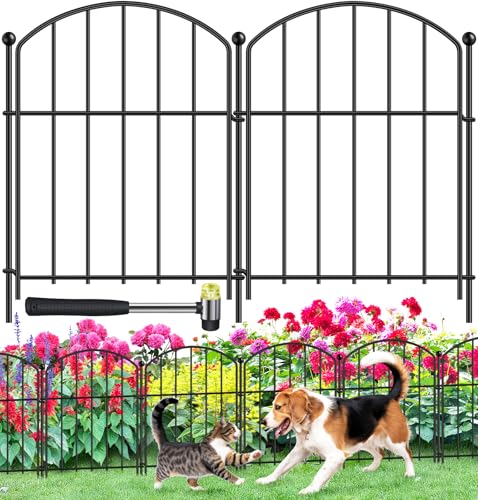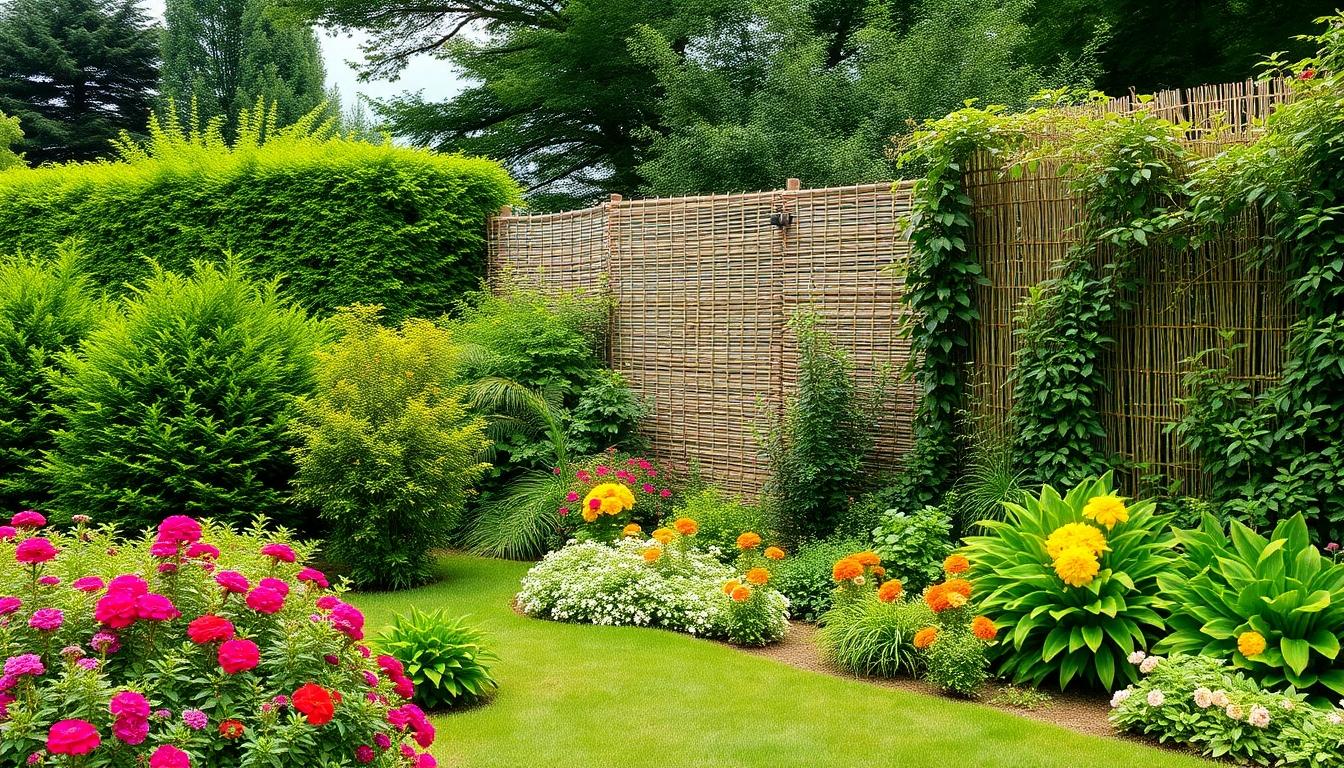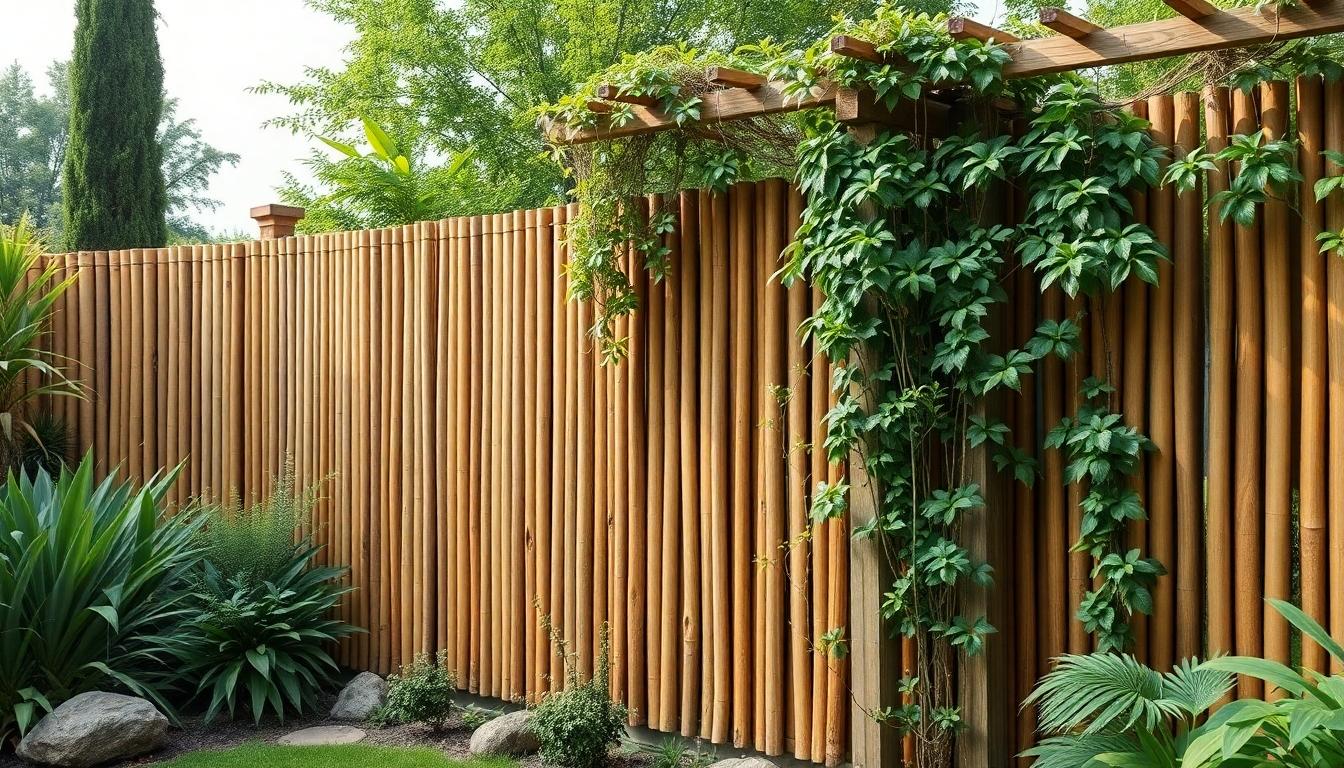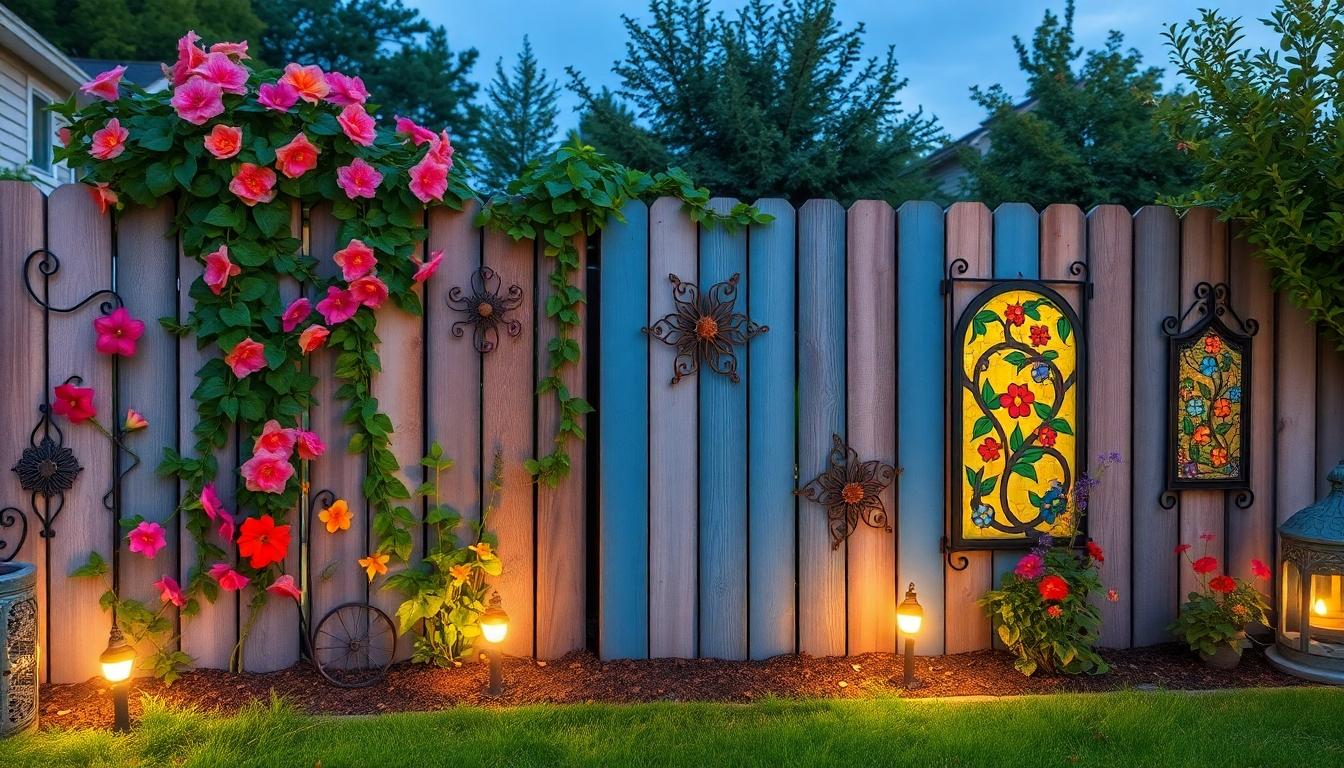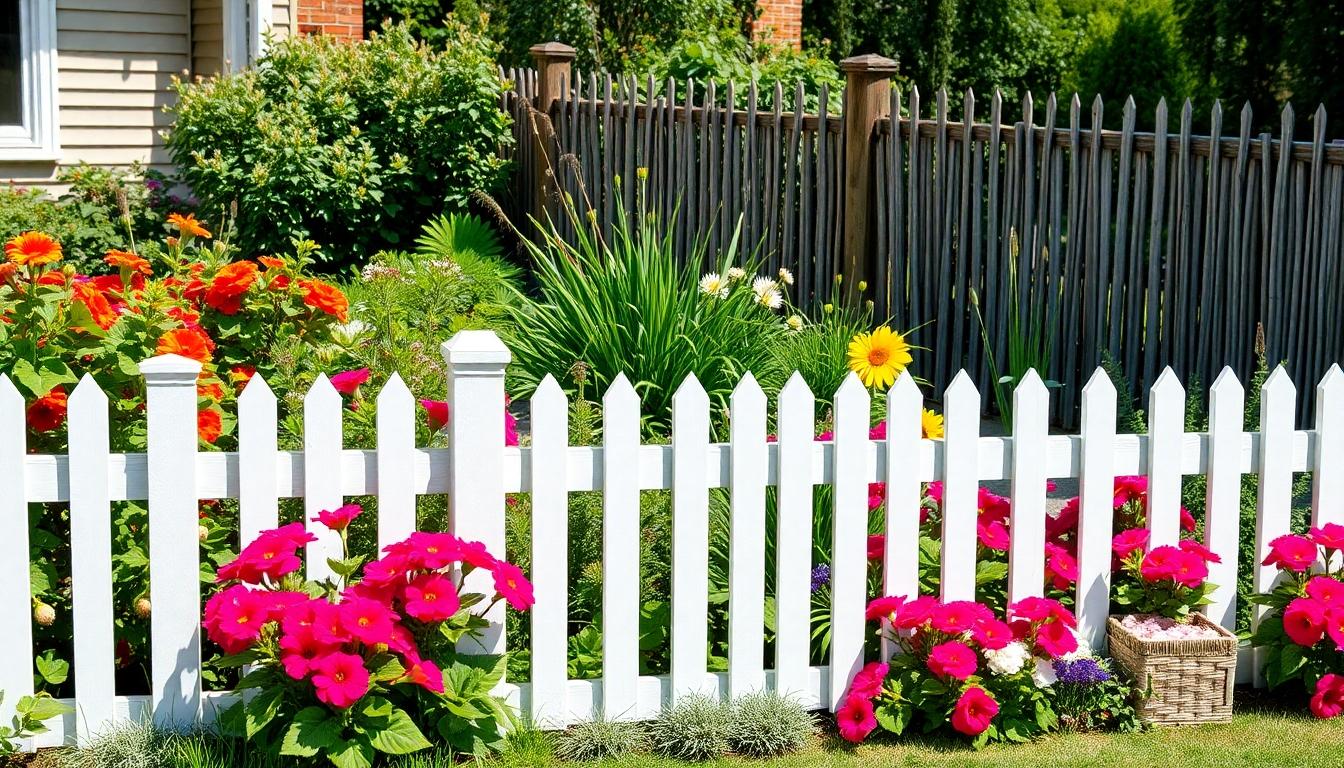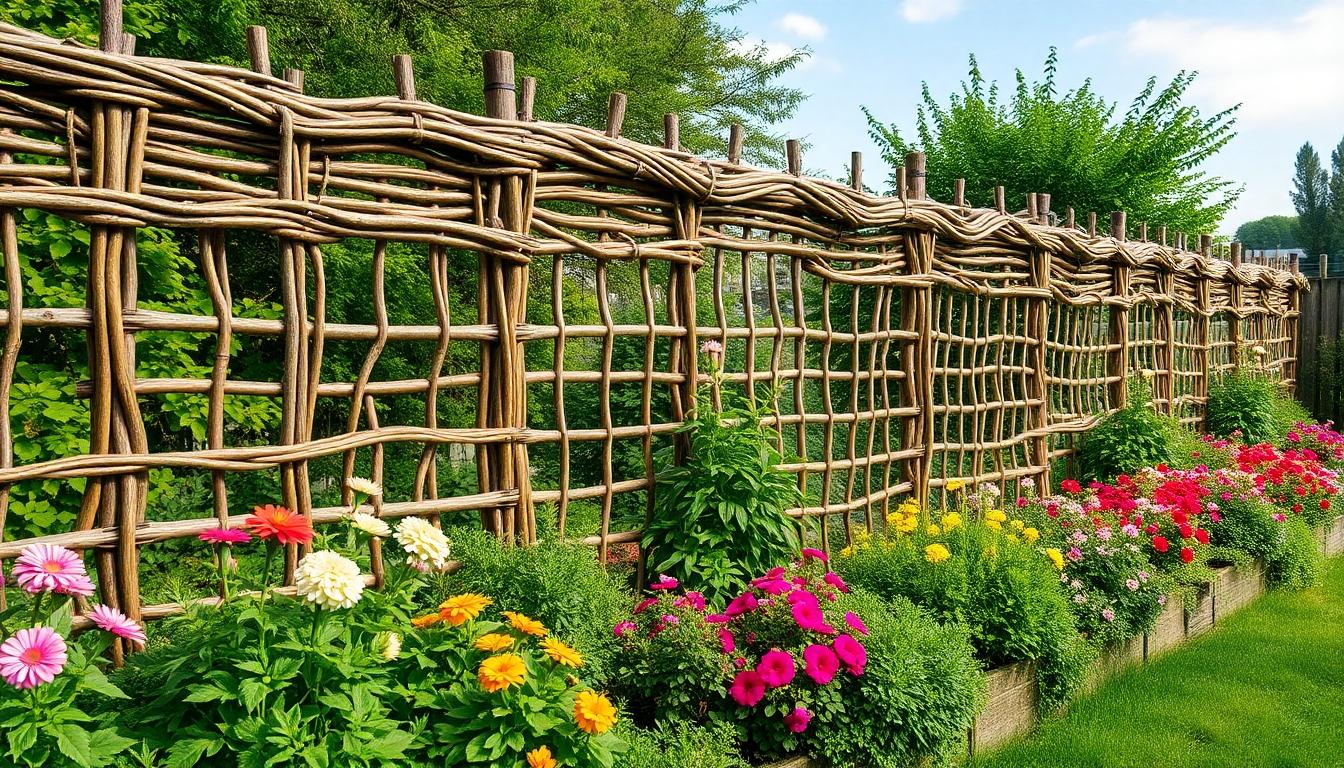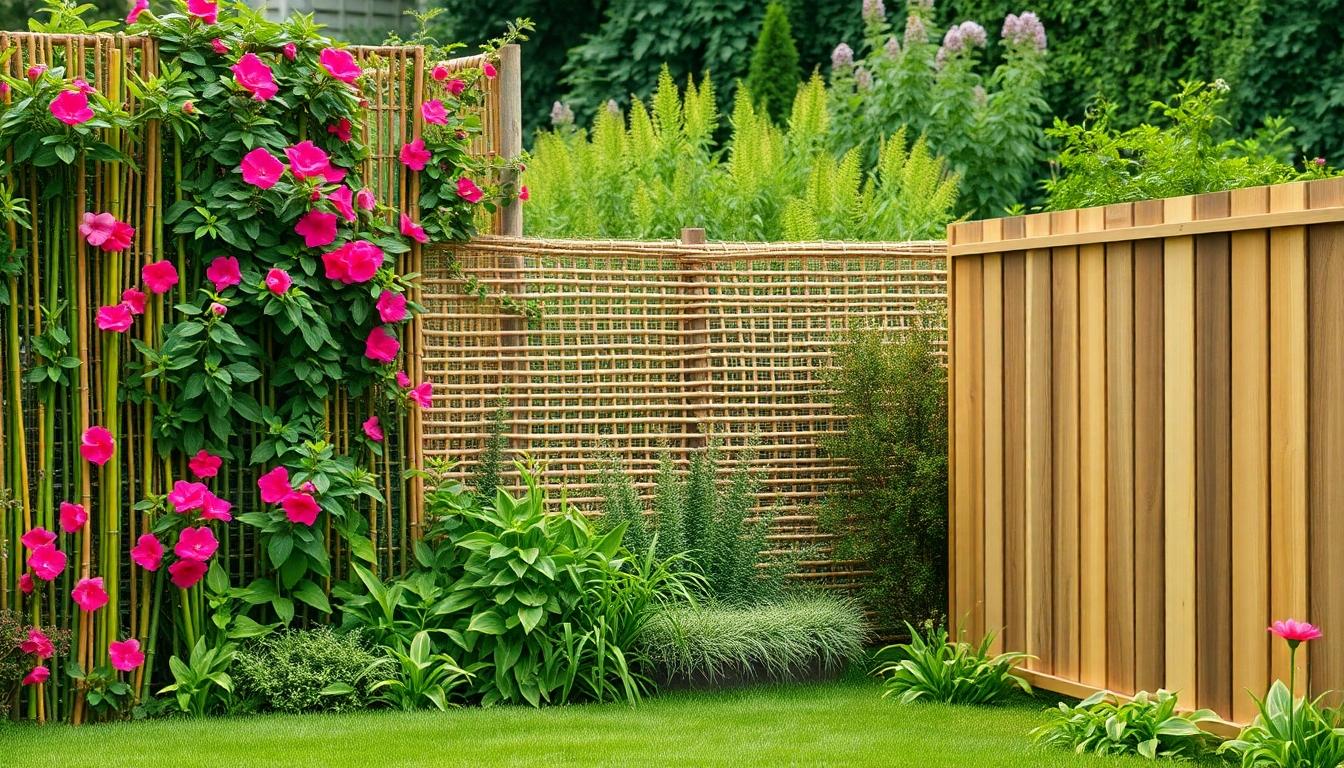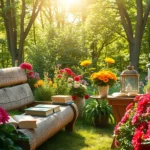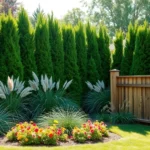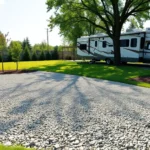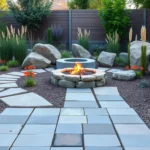Looking to transform your outdoor space? A stylish garden fence isn’t just about security—it’s an opportunity to elevate your industry design and create a personal sanctuary that reflects your style.
We’ve gathered the most inspiring garden fence ideas to help you reimagine your outdoor boundaries. Whether you’re aiming for rustic charm with wooden pickets, modern elegance with sleek metal panels, or a living green barrier with climbing plants, the right fence can dramatically enhance your garden’s appeal while providing the privacy and protection you need.
In this guide, we’ll explore creative fencing answers for gardens of all sizes and styles, from budget-friendly DIY options to luxurious custom designs that will make your neighbors stop and stare.
10 Charming Wooden Garden Fence Ideas
1. Classic Picket Fence
The timeless appeal of a white picket fence adds instant charm to any garden space. We recommend using cedar or redwood for their natural resistance to rot and insects. These traditional fences stand typically 3-4 feet tall with evenly spaced vertical slats, creating that picture-perfect cottage look many homeowners desire. Paint them crisp white for the quintessential American garden aesthetic or leave them natural for a more rustic appearance.
2. Rustic Split Rail Design
Split rail fences deliver authentic countryside character with minimal effort. Their horizontal wooden beams rest in X-shaped posts, creating an open, unobtrusive boundary that blends beautifully with natural landscapes. This design works wonderfully for larger properties, farmhouse-style gardens, or anywhere you want to define space without blocking views or wildlife movement.
3. Horizontal Slat Privacy Screen
Modern horizontal slat fences have become increasingly popular for contemporary garden designs. These fences feature wooden boards arranged horizontally rather than vertically, creating clean lines that expand visual space. Spacing between slats can be adjusted to control privacy levels while maintaining airflow. Cedar, pine, or pressure-treated lumber works excellently for this minimalist, sophisticated look.
4. Decorative Lattice Panels
Lattice panels offer both privacy and visual interest with their crisscross pattern. Their open design allows some visibility while filtering views and supporting climbing plants like jasmine, roses, or clematis. We love using lattice as full fence panels or as decorative toppers on solid fencing to add height without creating a fortress-like appearance.
5. Reclaimed Wood Fence
Eco-friendly and uniquely charming, reclaimed wood fences tell a story through their weathered appearance. Barn wood, pallets, or salvaged lumber can be repurposed into stunning fence designs with character impossible to replicate in new materials. Each board’s distinctive coloring, grain patterns, and natural aging create a one-of-a-kind garden boundary filled with rustic appeal.
6. Japanese-Inspired Bamboo
Bamboo fencing creates an exotic, zen-like atmosphere perfect for meditation gardens or Asian-inspired landscapes. Natural bamboo poles can be arranged vertically or horizontally, tied together with weather-resistant cord for an authentic look. This sustainable material grows quickly, making it an environmentally friendly choice that adds texture and distinctive charm to garden boundaries.
7. Shadowbox Privacy Fence
Shadowbox fences alternate boards on opposite sides of the rail, creating a solid appearance from the front while allowing airflow between the slats. This clever design provides complete privacy from straight-on viewing angles while still permitting breezes to pass through. The alternating pattern also ensures your fence looks identical from both sides—no “good side” facing only your neighbors.
8. Curved or Contoured Designs
Breaking away from straight lines, curved wooden fences follow the natural contours of your industry for a softer, more organic boundary. These custom designs can dip and rise with your yard’s topography or create gentle archways between sections. Though more complex to construct, curved fences reward with unique visual interest and a truly custom garden feature.
9. Board-on-Board Privacy
For maximum privacy without feeling boxed in, board-on-board fencing overlaps vertical planks to eliminate gaps while maintaining a textured, dimensional appearance. This technique creates subtle shadow lines that add visual depth to your garden perimeter. The overlapping construction also accommodates wood’s natural expansion and contraction with seasonal changes, reducing warping or gaps over time.
10. Mixed Material Wooden Fence
Combining wood with other materials creates distinctive, contemporary garden boundaries. Wooden frames filled with metal mesh, corrugated metal panels inserted between wooden posts, or stone pillars connected by wooden sections all create eye-catching hybrid designs. These combinations allow you to leverage wood’s warmth while incorporating other materials’ textures, colors, and properties for truly customized garden enclosures.
7 Modern Metal Garden Fence Designs
Metal garden fences offer durability and sleek aesthetics that can transform any outdoor space. Here are seven contemporary metal fence designs that blend functionality with modern style.
- Alternating Height Steel Fence – These innovative designs feature steel pickets at different heights, creating visual rhythm and interest in your garden industry. The varied heights blend rustic charm with modern elegance, making them versatile enough for any garden setting.
- Corrugated Metal Fence – Stylish and exceptionally durable, corrugated metal fencing adds an industrial-chic touch to contemporary gardens. This option provides necessary security while creating a distinctive textural element that stands out from traditional fencing materials.
- Aluminum Fence with Spaced Pickets – Perfect for gardens needing airflow and visibility, aluminum fences with evenly spaced vertical pickets offer a clean, sleek appearance. Their lightweight construction makes installation easier while still providing boundary definition.
- Steel Fence with Wood Accents – The combination of steel posts with wooden slats creates a sophisticated mixed-material look. This design works beautifully for gardens seeking to blend textures and styles, offering warmth from the wood and stability from the steel.
- Woven Metal Privacy Fence – Constructed from interwoven metal strips or wires, these artistic barriers provide privacy while maintaining aesthetic appeal. Gardens requiring seclusion benefit from these designs that filter light beautifully while keeping unwanted views out.
Decorative Steel Panels
Decorative steel panels represent one of the most customizable options in modern metal fencing. These panels can be laser-cut with intricate patterns, geometric designs, or even personalized motifs that reflect your garden’s theme. Many homeowners appreciate how these panels create distinctive shadow patterns when sunlight filters through them, adding an extra dimension to garden aesthetics.
Steel panels offer exceptional durability against weather conditions and require minimal maintenance compared to wood alternatives. Their sleek profiles complement contemporary architecture particularly well, creating a cohesive look between home and garden. For smaller spaces, decorative steel panels with open designs maintain a sense of spaciousness while still defining boundaries.
Wrought Iron Elegance
Wrought iron fencing brings timeless sophistication to garden landscapes with its classical beauty and ornate detailing. Traditional scrollwork, finials, and decorative elements showcase craftsmanship that has been valued for centuries yet fits perfectly in modern garden settings. These fences provide both security and visual appeal, with designs ranging from simple and understated to elaborately decorative.
The durability of wrought iron is legendary, often lasting generations with proper maintenance. Gardens framed by wrought iron gain a sense of established elegance and permanent structure that enhances plantings and hardscaping alike. Many homeowners choose wrought iron for its ability to frame views rather than block them, making it ideal for gardens with beautiful focal points or vistas worth highlighting. Even though its traditional roots, wrought iron complements both classic and contemporary garden designs, demonstrating its remarkable versatility as a fencing material.
8 Budget-Friendly DIY Garden Fence Projects
Looking for affordable ways to define your garden space? We’ve compiled eight creative DIY fence projects that won’t expensive while adding charm and functionality to your outdoor area.
- Pallet Fence: Transform free or inexpensive wooden pallets into a rustic garden boundary. Simply disassemble pallets to create vertical planks, then attach them to horizontal poles for a sturdy and stylish fence.
- Split Rail Fence: Create a country-inspired look using logs split lengthwise and stacked in a zigzag pattern. This natural-looking fence blends beautifully with surrounding landscapes and requires minimal construction skills.
- Bamboo Privacy Fence: Build an eco-friendly barrier using affordable bamboo sticks. The natural material can be woven together or secured side by side for increased privacy while adding a tropical aesthetic to your garden.
- Repurposed Wood Fence: Give new life to old wooden planks or boards by turning them into a unique garden fence. Enhance their appearance with paint or stain that complements your garden’s color scheme.
- Trellis Fence with Plants: Combine wooden trellises with climbing plants like ivy, roses, or jasmine. This living fence creates a lush, natural screen that evolves and becomes more beautiful over time.
- Black Plastic Net Fence: Install a simple barrier using black plastic netting and wooden stakes. This low-cost solution works perfectly for small gardens and provides basic boundary definition.
- Farmhouse Style Fence: Construct a classic fence using treated 4×4 posts and 1×4 planks. Add character with rustic stains or paints to achieve that charming farmhouse aesthetic.
- Reclaimed Wire Fence: Use old wire mesh or chicken wire with wooden posts to create a minimalist boundary. This design allows excellent airflow and visibility while keeping unwanted visitors out.
Pallet Fence Transformations
Pallet fences offer incredible versatility for budget-conscious gardeners. These structures use reclaimed materials that are often available for free from local businesses or online marketplaces. We’ve found that pallets can be easily dismantled and reconstructed in various configurations, from traditional vertical plank designs to more creative horizontal arrangements.
Customization options abound when working with pallet wood. The raw timber can be painted in bright colors for a playful garden feature or stained in natural tones for a more sophisticated appearance. Many gardeners enjoy creating two-tone effects or adding decorative elements like bottle caps, small planters, or solar lights to personalize their pallet fences.
Space efficiency makes pallet fencing particularly suitable for urban gardens or compact outdoor areas. The relatively thin profile of assembled pallet fences means they don’t take up valuable gardening space while still providing clear boundary definition and privacy where needed.
Repurposed Materials Magic
Old doors and windows create enchanting garden dividers with character impossible to find in new materials. We can mount vintage windows between posts to form a whimsical transparent fence that frames garden views like living photographs. Weathered doors placed side by side establish a solid boundary while telling stories through their worn paint and unique hardware.
Metal scraps transform into artistic fence elements when creatively repurposed. Corrugated tin roofing, bicycle wheels, bed springs, and even old garden tools can be incorporated into fence designs for eye-catching industrial-chic appeal. These metal components often require minimal preparation—just cleaning and perhaps a clear coat to prevent further rusting.
Unusual items like ladders, headboards, and shutters bring unexpected charm to garden boundaries. We’ve seen stunning examples where old wooden ladders are positioned horizontally between posts, creating open shelving for potted plants while defining garden rooms. Antique headboards make beautiful garden gates, while rows of shutters create adjustable privacy screens that can be opened to control light and views.
6 Living Garden Fence Options
Living garden fences blend functionality with natural beauty, creating boundaries that enhance your industry while supporting local ecosystems. These green alternatives offer privacy, windbreaks, and habitat for beneficial wildlife.
1. Hedges
Traditional hedges remain one of the most popular living fence options for good reason. Privet, boxwood, and yew varieties provide dense, natural barriers that can be trimmed to precise shapes and heights. These classic choices establish clear property lines while softening the industry with their lush greenery.
2. Flowering Shrubs
Flowering shrubs serve dual purposes as both boundary markers and stunning focal points in your garden. Hydrangeas showcase impressive blooms in summer and fall, while rose bushes offer fragrant flowers and interesting structure. Lilacs create seasonal bursts of color and fragrance, defining spaces beautifully while attracting pollinators to your garden.
3. Bamboo Screens
Fast-growing bamboo creates an exotic, modern aesthetic while providing excellent privacy screening. We recommend selecting clumping bamboo varieties rather than running types to prevent unwanted spreading throughout your garden. Bamboo’s tall, slender profile works particularly well in contemporary landscapes and small spaces where horizontal room is limited.
4. Willow Fencing
Live willow branches can be woven into fascinating living structures that root and grow over time. This ancient technique creates fences that strengthen naturally as they develop, forming unique, organic boundaries. Willow fencing brings a distinctive, artistic element to garden designs while providing effective screening.
5. Espaliered Trees
Fruit trees trained along trellises or wires create functional, space-saving living fences with edible benefits. Apple and pear varieties work exceptionally well for espalier techniques, forming flat, decorative patterns while producing harvests in even the smallest gardens. These living walls combine beauty with practicality in an elegant solution.
6. Evergreen Shrubs
Arborvitae and holly provide year-round coverage and substantial wind protection for gardens in exposed locations. These resilient evergreens maintain their screening capabilities through all seasons, ensuring privacy even during winter months when deciduous options stand bare. Their dense growth habits create effective barriers against noise and unwanted views.
Flowering Hedge Borders
Climbing roses like the popular ‘New Dawn’ variety transform ordinary trellises into spectacular flowering barriers that combine security with abundant blooms. These versatile plants can be trained along existing fences or standalone supports to create breathtaking flowering walls.
Lavender forms low-growing, fragrant hedges that naturally repel garden pests while thriving in sunny, dry conditions. This Mediterranean favorite creates beautifully scented borders that attract beneficial insects while defining garden spaces with distinctive silver-blue foliage.
Butterfly bush establishes loose, airy borders that become magnets for pollinators throughout the growing season. These fast-growing shrubs provide height and screening while supporting local butterfly populations, making them both functional and environmentally friendly options for garden boundaries.
Vertical Garden Fences
Trellis systems paired with vigorous climbers like clematis, jasmine, or beans create functional, space-efficient growing surfaces that maximize production in small areas. These versatile structures can be customized to any height or width, providing support for both ornamental and edible climbing plants.
Upcycled pallet walls mounted vertically with integrated planting pockets offer excellent growing space for herbs or succulents while adding rustic charm to garden boundaries. This sustainable approach repurposes materials that might otherwise end up in landfills, creating useful growing space and effective screening.
Wire grid panels provide sturdy support for climbing vegetables such as peas and cucumbers or flowering vines like morning glories. These practical structures allow for abundant harvests while creating seasonal privacy screens that change throughout the growing year, adding ever-changing interest to garden boundaries.
5 Privacy-Focused Garden Fence Solutions
Looking to create your own secluded outdoor haven? These privacy-focused fence answers combine functionality with style to shield your garden from unwanted views.
Tall Bamboo Screens
Bamboo fencing delivers natural aesthetics and rapid privacy for your garden space. Pre-made bamboo panels can be easily attached to existing wooden frames, creating an appealing contrast or standing independently as complete screens. Mahogany bamboo panels work exceptionally well when you need sectioned privacy areas throughout your garden. Rolled bamboo fencing offers versatility for curved spaces where rigid panels wouldn’t fit properly. Remember that bamboo requires proper sealing in humid climates to prevent mold development and maintain its beauty over time.
Lattice With Climbing Plants
Trellis structures paired with climbing vines create beautiful semi-opaque screens that enhance privacy while maintaining airflow. Jasmine, ivy, and other climbing plants gradually fill in the open spaces of lattice panels, forming a living privacy screen that evolves with the seasons. This approach adds valuable vertical greenery without creating a feeling of complete enclosure, striking the perfect balance between visual separation and open atmosphere. Cedar or pressure-treated wood lattice offers the best durability for this application, withstanding weather exposure while supporting plant growth.
Arbor-Pergola Hybrids
Tall arbors featuring roof-like tops or attached trellises provide excellent overhead coverage while defining garden boundaries. These structures effectively block second-story views from neighboring properties or buildings. Adding climbing plants to these hybrids creates layered privacy protection that feels natural rather than restrictive. Posts should be sunk 2-3 feet into the ground to ensure stability during high winds, especially for taller structures that catch more breeze.
Artificial Greenery Panels
Snap-together synthetic screens deliver instant, low-maintenance privacy for gardens where live plants might struggle. These 20″x20″ panels mimic the appearance of living plants without requiring watering, pruning, or seasonal care. Artificial greenery options prove ideal for temporary privacy answers or rental properties where permanent installations aren’t practical. When purchasing artificial panels, prioritize UV-resistant materials to prevent color fading from sun exposure.
Mixed-Height Stone Walls
Combining stone bases with openwork trellises or metal grids creates structural privacy with architectural interest. The solid lower section effectively blocks direct sightlines while the upper decorative section maintains crucial airflow through your garden space. This hybrid approach allows for customization based on your exact privacy needs and garden style. Partner modular metal or wood additions with stone for cost efficiency without sacrificing the elegant appearance of traditional stonework.
9 Decorative Garden Fence Accents
Transform your ordinary garden fence into a captivating focal point with these decorative accents that add personality and charm to your outdoor space.
- Painted Accents: Vibrant colors breathe new life into plain fences. Bold hues can define your garden’s theme or highlight exact sections, creating visual interest even during winter months.
- Lattice Panels: These decorative elements add texture and dimension to standard fences. Lattice provides excellent support for climbing plants like jasmine or clematis, doubling as both structure and living art.
- Metal Art: Decorative metal shapes and sculptures attach easily to fence panels. From whimsical animals to abstract designs, these durable accents withstand the elements while making a distinctive statement.
- Floral Vines: Training climbing plants to grow along your fence creates a living decoration. Morning glories, climbing roses, and ivy transform rigid boundaries into lush, natural displays that change with the seasons.
- Wind Chimes: Hanging musical elements adds a sensory dimension to your garden fence. Their gentle sounds create a peaceful atmosphere while drawing the eye upward with their decorative forms.
- Solar Lights: These practical accents illuminate paths while highlighting fence features. Energy-efficient solar options require no wiring and automatically activate at dusk, creating magical evening ambiance.
- Fence Toppers: Ornamental elements that sit atop fence posts add finishing touches to your garden boundary. From copper caps to glass balls, these decorative finials elevate the overall design.
- Mirror Accents: Reflective surfaces create the illusion of expanded space in smaller gardens. Weather-resistant mirror panels strategically placed on fences bounce light and visually double your plantings.
- Wood Carvings: Intricate designs carved into wooden fences provide permanent artistic elements. Custom patterns or nature-inspired motifs transform functional barriers into personalized art installations.
Integrated Lighting Features
Integrated lighting beautifully highlights garden features while creating a warm, inviting ambiance after sunset. Solar-powered fence lights offer hassle-free installation without wiring concerns, automatically illuminating at dusk. String lights woven through fence slats create a starry effect perfect for entertainment areas, with weatherproof varieties standing up to year-round exposure. In-ground uplighting positioned along fence lines dramatically showcases textures and colors, casting interesting shadows that transform your garden’s nighttime appearance. These lighting options not only enhance security but also extend your outdoor enjoyment well into the evening hours.
Artistic Panel Inserts
Artistic panel inserts instantly elevate ordinary fences into custom showpieces that reflect your personal style. Stained glass panels filter sunlight to cast colorful patterns across your garden, creating ever-changing displays that change throughout the day. Decorative metalwork inserts featuring botanical designs or geometric patterns add sophisticated visual interest without blocking airflow. Mosaic panels incorporating colorful tiles, glass pieces, or stones introduce texture and color that withstand outdoor conditions. These customizable elements allow you to coordinate with your overall garden design while breaking up expanses of solid fencing. Artistic inserts work particularly well in transition areas between garden rooms or as focal points visible from main seating areas.
7 Low Garden Fence Ideas for Defined Borders
Creating boundaries in your garden doesn’t always require tall, imposing structures. Low garden fences offer the perfect solution for defining spaces while maintaining an open, inviting atmosphere. Here are seven excellent low fence options that provide clear borders without overwhelming your outdoor space:
- Classic Picket Fence: This timeless option works beautifully for smaller yards and suburban neighborhoods. Picket fences create a charming, traditional boundary at an affordable price point of approximately $50 per 8-foot panel. Their distinctive shape and modest height make them perfect for framing front gardens or separating different planting areas.
- Rustic Split Rail Fence: Perfect for farmhouses and ranch-style homes, split rail fencing requires less material than solid designs. This cost-effective option ranges from $12 to $30 per linear foot and adds rustic charm while clearly marking boundaries. The open design maintains sightlines throughout your property while still establishing distinct zones.
- Ivy Wall with Climbing Plants: Transform existing low walls into living boundaries by adding climbing plants like bougainvillea or ivy. This approach combines hardscaping with natural elements to create a soft, green border that evolves with the seasons. Plants soften the appearance of structural elements while adding texture and color.
- Shortened Wrought Iron Sections: Low wrought iron fencing offers sophisticated style at a more affordable price than full-height versions. Typically costing between $25 and $35 per linear foot, these elegant barriers provide definition without blocking views. Their decorative patterns add visual interest while maintaining an open feel.
- Short Wooden Fence: Similar to picket styles but available in various designs, short wooden fences clearly define borders without dominating the industry. These versatile options can be customized with different finishes, caps, and spacing to complement your garden’s aesthetic while keeping the height modest.
- Living Fence (Vertical Garden): Incorporate plants directly into your border with a vertical garden design. This space-efficient solution creates lush boundaries without requiring extensive ground space. Living fences combine structure with greenery to form natural-looking divisions that support biodiversity.
- Climbing Plant Trellis: Lightweight trellis structures provide support for climbing plants to create natural fence lines. These enhance garden aesthetics while maintaining clear sightlines across your outdoor space. As plants grow, they transform simple frameworks into verdant, flowering boundaries that change with the seasons.
Each of these low garden fence ideas offers unique advantages for defining spaces while maintaining an open, welcoming atmosphere in your outdoor areas. Their modest heights provide clear boundaries without creating visual barriers, making them perfect for front yards, garden rooms, or areas where you want to maintain connection between spaces.
5 Rustic Garden Fence Inspirations
1. Wattle Fence
Wattle fences bring authentic historical charm to any garden industry, dating back to the Middle Ages. These natural barriers are crafted entirely from tree branches woven together in traditional patterns. The organic appearance blends seamlessly with garden surroundings, creating a boundary that feels like an extension of nature rather than an imposed structure. We particularly love how wattle fencing weathers over time, developing character and patina that only enhances its rustic appeal.
2. Twig Picket Fence
Twig picket fences offer a delightful rustic alternative to conventional picket designs, using small branches and twigs arranged in widely spaced vertical elements. This airy structure allows ample light transmission while still defining garden boundaries effectively. Many gardeners install these charming barriers around vegetable patches to keep pets at bay while maintaining aesthetic appeal. The varied textures and natural imperfections of the twigs create visual interest that manufactured fencing simply cannot match.
3. Lattice Fence
Lattice fences constructed from diagonally crossed twigs provide a natural framework that serves multiple functions in the garden. These open-weave structures offer minimal privacy but maximum versatility as supports for climbing plants and vines. Roses, clematis, and morning glories thrive when trained across these rustic lattices, transforming simple boundaries into living tapestries of color and texture. The diagonal pattern adds architectural interest even before plants begin their ascent.
4. Russel or Zig-Zag Fence
Russel fences, also known as zig-zag fences, introduce distinctive geometric patterns that instantly elevate garden design. The signature alternating pattern requires no posts or digging, making it surprisingly practical even though its decorative appearance. We can customize the spacing between materials to control privacy levels without sacrificing the unique rustic charm. These versatile structures work beautifully as standalone features or as dividers between different garden zones.
5. Twig Palisade Fence
Twig palisade fences feature closely spaced vertical elements that provide enhanced privacy while maintaining a completely natural aesthetic. This design offers greater seclusion for intimate garden spaces or areas where more screening is desired. The tight arrangement of vertical twigs creates a more substantial barrier while still feeling organic and handcrafted. Gardens requiring both rustic charm and functional privacy benefit tremendously from this traditional fencing approach that balances beauty with practicality.
6 Sustainable Eco-Friendly Garden Fence Alternatives
1. Biocomposite Fencing
Biocomposite fencing offers an innovative solution made from recycled plastics and agricultural byproducts like wheat straw. These eco-friendly barriers require absolutely no painting or sealing, making them virtually maintenance-free while providing exceptional durability. Products like Natures Composites stand up to harsh weather conditions year after year without deterioration. We’re particularly impressed by how these fences repurpose waste materials that would otherwise end up in landfills, creating a truly sustainable boundary for any garden space.
2. Bamboo Fencing
Bamboo represents one of nature’s most renewable resources, growing up to an astonishing 3 feet daily in optimal conditions. This remarkable plant naturally resists termites thanks to its high silica content, eliminating the need for chemical treatments. Properly installed bamboo fencing can withstand hurricane-force winds while costing significantly less than traditional wood options. The sleek, natural appearance of bamboo complements various garden styles from tropical to contemporary, making it both an environmentally and aesthetically pleasing choice.
3. Living Fences
Living fences transform boundary lines into thriving ecosystems through carefully selected plants like willow or laurel. These natural barriers enhance biodiversity by providing habitat for birds and beneficial insects while actively absorbing carbon dioxide from the atmosphere. Once established, living fences require minimal maintenance beyond occasional pruning to maintain desired heights and widths. Their seasonal changes offer ever-changing visual interest throughout the year, with possibilities for flowering varieties that attract pollinators to your garden.
4. Woven Hurdle/Reed Fencing
Woven hurdle fencing showcases traditional craftsmanship using coppiced wood or bamboo arranged in attractive patterns. These biodegradable barriers create instant rustic charm while being surprisingly DIY-friendly for gardeners with basic skills. Natural materials like hazel branches or dried reeds form the basis of these fences, which blend seamlessly into natural garden settings. Their organic appearance softens garden boundaries while allowing for airflow and filtered light, creating a less imposing perimeter than solid fencing options.
5. SimTek Ecostone Recycled Fencing
SimTek Ecostone represents cutting-edge sustainable technology with its rotationally molded fencing made from recycled materials. This innovative product convincingly mimics the appearance of natural stone while offering extreme durability in temperatures ranging from -40°F to 140°F. Sound-blocking capabilities are impressive, with tests showing it blocks 98% of direct sound transmission. Gardens in urban environments particularly benefit from this zero-maintenance option that combines privacy, noise reduction, and environmental responsibility in one sophisticated package.
6. Dead Hedging
Dead hedging transforms garden waste into functional boundaries by repurposing fallen branches and brush into structured barriers. This cost-free approach eliminates the need for new materials while creating valuable microhabitats for wildlife and beneficial insects. Garden cleanup becomes more purposeful as trimmed branches find new life in these biodegradable structures rather than being hauled away. Soil health improves around dead hedges as organic matter gradually breaks down, returning nutrients to the surrounding industry in a perfect example of closed-loop gardening.
| Fence Type | Materials | Maintenance | Durability | Key Benefit |
|---|---|---|---|---|
| Biocomposite | Recycled plastic, wheat straw | None | High | Weather-resistant, no upkeep |
| Bamboo | Bamboo stalks | Low | High | Rapidly renewable, pest-resistant |
| Living Fence | Plants/shrubs | Moderate | Moderate | Carbon-absorbing, biodiverse |
| Woven Hurdle | Wood/bamboo reeds | Low | Moderate | Biodegradable, DIY-friendly |
| SimTek Ecostone | Recycled materials | None | Extreme | Soundproof, storm-resistant |
| Dead Hedging | Fallen branches | Low | Short-term | Zero-cost, wildlife-friendly |
How to Choose the Perfect Garden Fence for Your Space
Selecting the right garden fence transforms not just your boundaries but your entire outdoor experience. From charming wooden pickets to modern metal designs sustainable living barriers and budget-friendly DIY projects we’ve explored countless options to enhance your garden.
Remember that the perfect fence balances functionality with personal style. Consider your primary needs—privacy security or simply defining spaces—alongside your aesthetic preferences and maintenance capacity.
Whether you opt for the timeless appeal of a rustic split rail the contemporary elegance of decorative steel panels or the eco-friendly charm of a living fence your choice will frame your garden for years to come. The right fence doesn’t just surround your space—it completes it elevating your outdoor sanctuary to its full potential.
Frequently Asked Questions
What are the benefits of garden fences beyond security?
Garden fences offer much more than just security. They enhance outdoor design, create personal sanctuaries, define spaces, and can serve as decorative elements. The right fence can transform your garden’s aesthetic, provide privacy, act as a windbreak, support climbing plants, and even increase property value. They also help establish boundaries while complementing your overall landscape design.
What are some budget-friendly DIY garden fence options?
Budget-friendly DIY options include pallet fences from reclaimed materials, rustic split rail designs, bamboo privacy screens, repurposed wood fences, trellis-plant combinations, black plastic netting, farmhouse-style fences, and reclaimed wire barriers. These projects use affordable or recycled materials while adding charm and functionality to your garden without breaking the bank.
How can I create a living garden fence?
Create a living garden fence by planting traditional hedges, flowering shrubs, bamboo screens, willow fencing, espaliered trees, or evergreen shrubs. These options provide privacy and windbreaks while supporting local ecosystems. You can also incorporate climbing plants like roses on trellis systems or create vertical gardens using upcycled pallets to maximize space while adding natural beauty.
What are the best fencing options for privacy?
For maximum privacy, consider tall bamboo screens for rapid coverage, lattice structures with climbing plants for semi-opaque screening, arbor-pergola hybrids for overhead coverage, artificial greenery panels for low-maintenance solutions, or mixed-height stone walls combined with decorative trellises. Metal options like corrugated steel or woven metal privacy fences also offer excellent seclusion.
How can I make my garden fence more decorative?
Enhance your fence with painted accents, lattice panels, decorative metal art, floral vines, wind chimes, solar lights, decorative toppers, mirror accents, or wood carvings. You can also incorporate integrated lighting features for ambiance and security or add artistic panel inserts to transform ordinary fences into custom showpieces that express your personal style.
What are good low fence options for garden borders?
Low fence options include classic picket fences, rustic split rails, ivy walls with climbing plants, shortened wrought iron sections, short wooden borders, living fences with vertical gardens, and climbing plant trellises. These provide defined boundaries while maintaining an open atmosphere, making them perfect for front yards and garden room divisions.
What sustainable options exist for eco-friendly garden fencing?
Eco-friendly options include biocomposite fencing made from recycled materials, rapidly renewable bamboo, biodiversity-enhancing living fences, woven hurdle fencing, SimTek Ecostone recycled fencing that mimics stone, and dead hedging that repurposes garden waste. These sustainable alternatives offer environmental benefits while providing durability and aesthetic appeal.
What are some rustic garden fence ideas?
Rustic garden fence ideas include wattle fences woven from tree branches, twig picket fences, lattice fences supporting climbing plants, Russel or zig-zag fences with distinctive geometric patterns, and twig palisade fences for enhanced privacy. These natural options add character and charm while blending seamlessly with the garden environment.
How durable are metal garden fences compared to wooden ones?
Metal garden fences generally offer superior durability compared to wooden ones. They resist rot, insects, and weathering, requiring less maintenance over time. Options like steel, aluminum, and wrought iron can last decades with proper care. While typically more expensive initially, their longevity often makes them more cost-effective in the long run compared to wood fences that may need replacement sooner.
Can I combine different materials in my garden fence design?
Absolutely! Combining materials creates unique, eye-catching fences. Popular combinations include steel fences with wood accents, stone bases with metal or wood upper sections, and wooden frames with metal inserts. Mixed-material fences allow you to enjoy the benefits of different materials while creating a custom look that complements your garden’s style and meets your specific needs.

